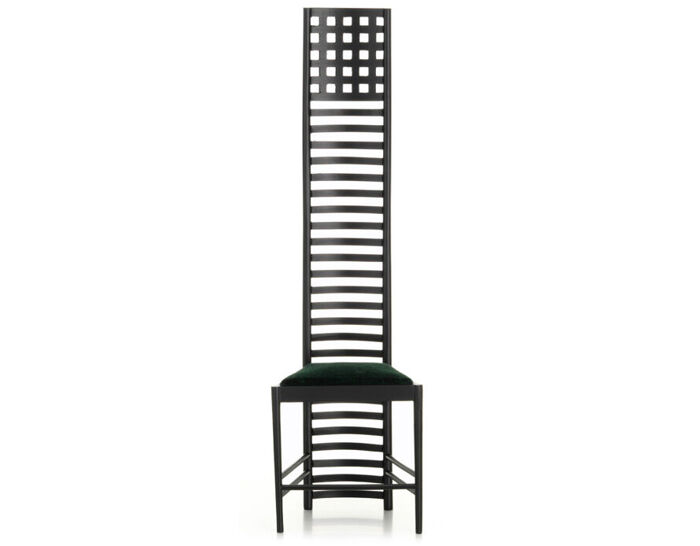Miniature Hill House 1 Chair
from Vitra.
miniature hill house 1 chair
Design Charles Rennie Mackintosh, 1903
1/6 miniature scale model
Made in Poland by Vitra
For over two decades, the Vitra Design Museum has been making miniature replicas of milestones in furniture design. The Miniatures Collection encapsulates the entire history of industrial furniture design - moving from Historicism and Art Nouveau to the New Objectivity of Bauhaus and Radical Design, and from Postmodernism all the way up to the present day. Exactly one sixth of the size of the historical originals, the chairs are all true to scale and precisely recreate the smallest details of construction, material and color. The high standard of authenticity even extends to the natural grain of the wood, the reproduction of screws and the elaborate handicraft techniques involved. This has made the miniatures into popular collector's items as well as ideal illustrative material for universities, design schools and architects.
Charles Rennie Mackintosh was one of the great representatives of Art Nouveau. Together with his wife Margaret McDonald, her sister Frances, and his brother-in-law Herbert McNair, he developed an original style that set itself apart from the decorative floral style of Jugendstil. The group's geometric, almost cubist designs for furniture show the influence of Japanese spacial concepts and are distinguished by their elongated, severe forms. A typical aspect of their work is a formal scheme based on horizontal and vertical lines, occasionally combined with slightly curved linear ornamentation.
Hill House 1 marks a new phase in the work of Mackintosh. The chair's strict geometry recalls the Ladderback Chairs of the Shakers and clearly differs from the organic or feminine forms of early designs. It was made for the house of a Scottish publisher and his wife and functioned more as part of an artistic environment than as a piece of furniture for everyday use. The chair was assigned a set place in the bedroom of the couple, where it fulfilled a purely decorative function. The extended back, first used by Mackintosh in 1897, is a motif that appears repeatedly in his chairs and gives them an unmistakable quality.
Each Vitra miniature is true to the original in construction and materials, and reduced in size on a scale of 1:6. Each miniature is packaged in a wooden box, accompanied by an informational booklet. Production notes: Each of the delicate objects are made by hand; on average, each miniature requires five hours of careful manual work. Ongoing quality control ensures that every miniature corresponds to its larger original in terms of finishing, details and materials.
9.25" h | 2.5" w | 2.4" d
1/6 miniature scale model
Made in Poland by Vitra
For over two decades, the Vitra Design Museum has been making miniature replicas of milestones in furniture design. The Miniatures Collection encapsulates the entire history of industrial furniture design - moving from Historicism and Art Nouveau to the New Objectivity of Bauhaus and Radical Design, and from Postmodernism all the way up to the present day. Exactly one sixth of the size of the historical originals, the chairs are all true to scale and precisely recreate the smallest details of construction, material and color. The high standard of authenticity even extends to the natural grain of the wood, the reproduction of screws and the elaborate handicraft techniques involved. This has made the miniatures into popular collector's items as well as ideal illustrative material for universities, design schools and architects.
Charles Rennie Mackintosh was one of the great representatives of Art Nouveau. Together with his wife Margaret McDonald, her sister Frances, and his brother-in-law Herbert McNair, he developed an original style that set itself apart from the decorative floral style of Jugendstil. The group's geometric, almost cubist designs for furniture show the influence of Japanese spacial concepts and are distinguished by their elongated, severe forms. A typical aspect of their work is a formal scheme based on horizontal and vertical lines, occasionally combined with slightly curved linear ornamentation.
Hill House 1 marks a new phase in the work of Mackintosh. The chair's strict geometry recalls the Ladderback Chairs of the Shakers and clearly differs from the organic or feminine forms of early designs. It was made for the house of a Scottish publisher and his wife and functioned more as part of an artistic environment than as a piece of furniture for everyday use. The chair was assigned a set place in the bedroom of the couple, where it fulfilled a purely decorative function. The extended back, first used by Mackintosh in 1897, is a motif that appears repeatedly in his chairs and gives them an unmistakable quality.
Each Vitra miniature is true to the original in construction and materials, and reduced in size on a scale of 1:6. Each miniature is packaged in a wooden box, accompanied by an informational booklet. Production notes: Each of the delicate objects are made by hand; on average, each miniature requires five hours of careful manual work. Ongoing quality control ensures that every miniature corresponds to its larger original in terms of finishing, details and materials.
9.25" h | 2.5" w | 2.4" d
Vitra is a Swiss company dedicated to improving the quality of life through the power of design. A central goal of Vitra is sustainable development. Trendy styling is avoided in favor of classic pieces that can be used for decades.












 write a review now
write a review now